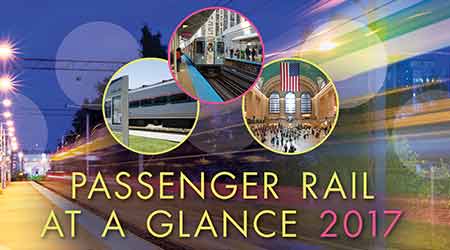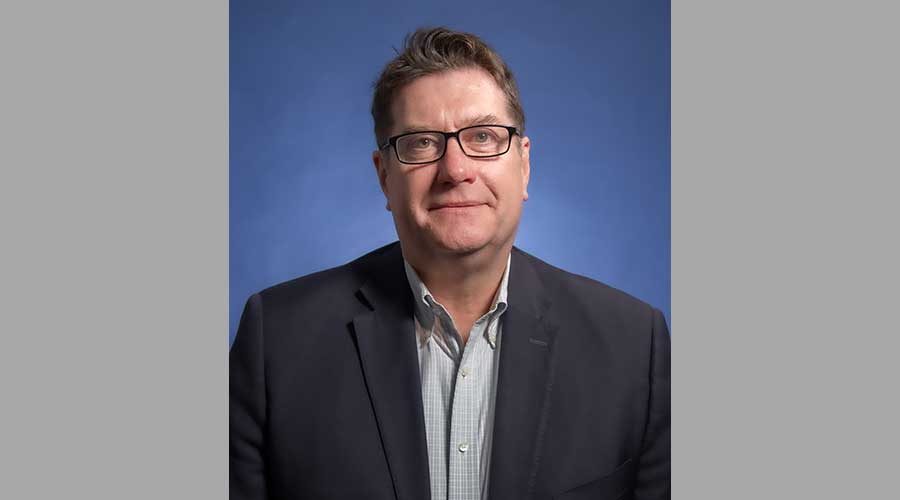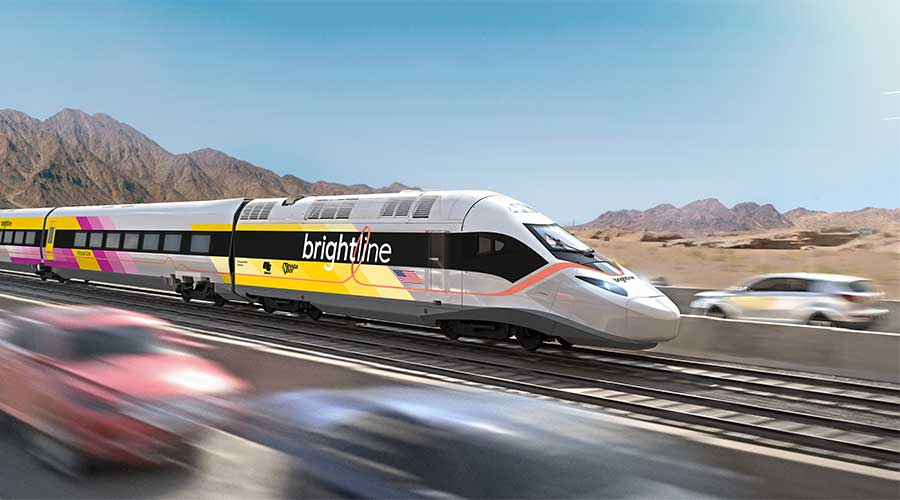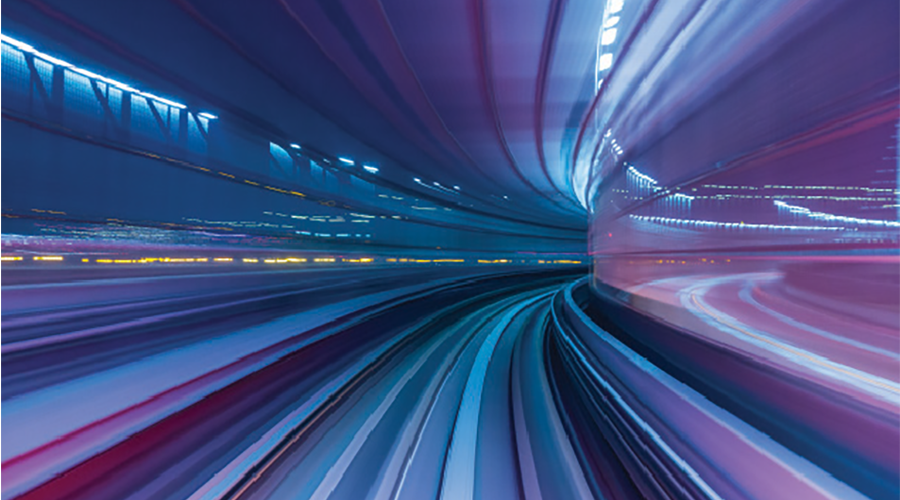Stay updated on news, articles and information for the rail industry
October 2017
Part 1 : Progressive Railroading's Passenger Rail at a Glance 2017: Preface
Part 2 : Progressive Railroading's Passenger Rail at a Glance 2017: Amtrak, California, & Colorado
Part 4 : Progressive Railroading's Passenger Rail at a Glance 2017: New Jersey, New York, & Ohio
Part 5 : Progressive Railroading's Passenger Rail at a Glance 2017: Pennsylvania, Texas, & Washington
Rail News: Passenger RailProgressive Railroading's Passenger Rail at a Glance 2017: New Jersey, New York, & Ohio

NEW JERSEY
New Jersey Transit
Operating budget: $2.2 billion
NJ Transit is the nation’s largest statewide public transportation system providing more than 944,000 weekday trips on 255 bus routes, three light-rail lines, 12 commuter-rail lines and through Access Link paratransit service. It is the third largest transit system in the country with 166 rail stations, 62 light-rail stations and more than 18,000 bus stops linking major points in New Jersey, New York and Philadelphia.
Service launched: Commuter rail, 1979; light rail, 1935
Route Miles: Light rail — 13.92 miles for the Newark line; 36 miles for Hudson-Bergen (HBLR) Line; and 56 miles for the RiverLINE. Directional route miles for commuter-rail is 1 billion; annual passenger miles is 2.1 billion.
Rolling stock: 196 locomotives, average age 11.5 years; 1,113 rail cars, average age 16 years; light-rail vehicles, 21 for Newark line, average age 17 years; 20 LRVs for RiverLINE, average age 13 years; 52 LRVs, HBLR line, average age 17 years
Annual ridership: 2.3 million light rail, 91 million commuter rail
Annual Operating budget: $2.218 billion (systemwide for FY2018)
Annual capital budget: $1.367 billion (FY2018)
Stations: 62 light rail, 166 commuter rail
Major capital improvement projects underway:
In FY2018, NJ Transit will continue its financial commitment to advancing positive train control implementation, the agency’s system resiliency program, rail station improvements and enhancements to light-rail infrastructure.
Port Authority Transit Corp.
Operating budget: $54.5 million
The Port Authority Transit Corp. (PATCO) is a rapid transit line from Center City Philadelphia to Lindenwold, New Jersey.
Service launched: Heavy rail, 1969.
Miles: 14.5
Rolling stock: 120 rail cars; average age 15 years
Annual ridership: 10.65 million
Annual operating cost: $54.5 million (heavy rail)
Annual capital cost: $75 million (heavy rail)
Stations: 13
Major capital improvement projects:
• Transit car overhaul — This $194 million project refurbishes all 120 rail cars in PATCO’s fleet. As of August 2017, 62 cars have been refurbished. Estimated completion is end of 2018.
• Lindenwold Yard rehabilitation — This $36 million project consists of track rehabilitation, turnout and switch rehabilitation, electrical improvements to the PATCO storage yard and maintenance building approach tracks. Estimated completion is 2019.
• Elevator installation — This $31.9 million project will install new elevators at the Ashland, Haddonfield, Westmont, Collingswood, City Hall and 12/13th & Locust Street stations. Estimated completion is 2021.
• Hall and Way interlocking rehabilitation — This $2.5 million project consists of turnout and switch replacement in two interlockings.
• Embankment restoration (Phase 5) — This $8 million project will work on restoring embankments along the right of way, drainage improvements and rehabilitation of trackway retaining walls at various locations along the system.
• Electrical substation equipment replacement program — This $9.2 million, multiyear program will replace electrical breakers, switches and electrical gear in substations. Most equipment is original to when the system was constructed in the late 1960s.
NEW YORK
MTA Long Island Rail Road*
Operating budget: $1.98 billion
The MTA Long Island Rail Road (LIRR) is the largest commuter railroad in the United States. Chartered in 1834, it extends from three major New York City Terminals — Penn Station, Atlantic Terminal and Hunterspoint Avenue — through a major transfer hub at Jamaica to the easternmost tip of Long Island.
Service launched: 1834
Track Miles: 700
Annual ridership: 89.3 million (2016)
Annual operating expenses: $1.98 billion (2017)
Capital budget: $3 billion (per MTA 201-2019 Capital Program report)
Stations: 124
Major capital improvement projects underway include: LIRR’s expansion proposal calls for adding a third track to the LIRR Main Line. The project is expected to reduce automobile traffic congestion by adding train options and eliminating grade crossings.
*Information source: mta.info, MTA reports
MTA Metro-North Railroad
Operating budget: $1.5 billion
MTA Metro-North was created in 1983 when the MTA assumed control of Conrail’s suburban and commuter operations in the states of New York and Connecticut. Metro-North operates three main lines — the Hudson, Harlem and New Haven — each extending over 70 miles north and east from Grand Central Terminal in Manhattan and serving 111 stations. The 95-mile Port Jervis and 30-mile Pascack Valley lines west of the Hudson River extend north from New Jersey Transit’s terminal in Hoboken, N.J., connecting with service from Penn Station in New York City, at Secaucus Transfer and serving 11 stations in New York.
Service launched: 1983
Route Miles: 391
Rolling stock: 69 locomotives, average age 18 years; 1,195 rail cars, average age 15 years
Rolling stock on order: 60 EMU cars manufactured by Kawasaki; expected delivery in 2020
Annual ridership: 86.6 million
Annual operating expense: $1.5 billion
Annual capital cost: $350 million
Stations: 124*
Major capital improvement projects:
• Positive train control (PTC). Metro-North is spending $367 million in its 2005-2009, 2010-2014 and 2015-2019 capital programs (along with an additional $157 million from Connecticut Department of Transportation) to comply with the Rail Safety Improvement Act of 2008, which requires full implementation of a PTC system by Dec. 31, 2018. SYSTRA and AECOM are providing design services; Bombardier Transportation is serving as the systems integrator.
• Harmon EMU Shop. Harmon is Metro-North’s oldest, largest and most critical rolling stock maintenance facility, servicing nearly 500 EMUs, more than 200 coaches and 55 locomotives. Over several capital programs, Metro-North is spending more than $1 billion in four phases to replace the various shop facilities, originally built in 1910. Replacement of the Main Shop (Phase V), where EMU’s were traditionally repaired and the last shop facility to be replaced, is underway and includes two stages. Phase V Stage I — $315 million funded under the 2010-2014 capital program — includes the design-build of a consist shop and a new stand-alone wheel shop (EMU Annex). Construction is underway with completion anticipated in 2018. Phase V Stage II includes the design-build of a running repair and support shops. Cost: $431 million funded under the 2015-2019 capital program. Preliminary design is underway with construction anticipated to begin in 2018.
• Hurricane Sandy repairs. In October 2012, Hurricane Sandy submerged significant portions of the Hudson Line, damaging track and immersing over 30 miles of signal and power systems from Harlem to Croton Harmon in highly corrosive salt water. Metro-North is repairing the right of way and replacing signal and power infrastructure, hardening systems to the maximum extent feasible considering the location immediately adjacent to the Hudson River. Design for the signal and power replacement by Gannett Fleming is complete. A design-build contract was awarded to Judlau-TC Electronic Joint Venture in May 2015 to construct the segment of the Hudson Line from Greystone to Croton-Harmon to be followed by the Bronx to Greystone segment.
*Includes Grand Central Terminal and Suffern; Suffern is in New York, but operated by New Jersey Transit.
MTA New York City Transit*
Operating budget: $12.9 billion
The subway opened in 1904. It travels through underground tunnels and elevated structures in the boroughs of Manhattan, Queens, Brooklyn and the Bronx. On Staten Island, NYCT’s Staten Island Railway links 22 communities.
Miles: 665 mainline track (includes Jan. 1, 2017, opening of Second Avenue Line)
Rolling stock: 6,418 rail cars
Annual ridership: 1.757 billion (2016)
Total Operating budget: $12.9 billion (projected for 2018)
Capital budget: $14.5 billion for 2015-2019, according to the MTA Capital Program report
Stations: 472
Major capital improvement projects: The MTA Capital Program 2015-2019 continues the subway system’s revitalization by purchasing new subway cars, modernizing signal interlockings, replacing track and making other critical investments.
*Information sources: mta.info/nyct, MTA reports
MTA Staten Island Railway*
Operating budget: $63.8 million
The railway links 22 communities in the New York City borough of Staten Island.
Service launched: 1860
Track Miles: 29
Rolling stock: 63 rail cars
Annual ridership: 4.5 million
Total Operating budget: $63.8 million (projected for 2018)
Annual capital cost: NA
Stations: 21
*Information sources: mta.info/sir, MTA reports
OHIO
Greater Cleveland Regional Transit Agency
Operating budget: $302.9 million
GCRTA provides public transit services to Cuyahoga County. Services include heavy and light rail.
Service launched: light rail, 1913; heavy rail, 1955
Miles: 15.3, light rail; 19, heavy rail
Rolling stock: 1 locomotive, average age 34 years; 60 rail cars, average age 35 years; 48 light-rail vehicles, average age 33 years
Annual ridership: 2.6 million,light rail; 6.4 million, heavy rail
Annual Operating budget: $302.9 million (FY2017)*
Annual capital cost: $29.7 million (overall)
Stations: 34 light rail; 18 heavy rail
Major capital improvement projects: 3 light-rail grade crossings replacement, $3 million, Delta RR Construction, 2016; 3 light rail grade crossings replacement, $3.4 million, 2017; 3 substations replacement with modular, $6 million, 2017; fiber optic system replacement, $8 million 2017-18; track rehabilitation West 30th to West 98th, $8.5 million 2017-18; Track 8 replacement, $5.1 million, Delta RR Construction, 2016; Brookpark Station Reconstruction, Mid American Construction, $12.2 million, 2016; East 116th Station Reconstruction, $4.5 million 2016-18; East 34th Station Reconstruction, $5.3 million 2017-18; East Boulevard Track Bridge Reconstruction, $1.9 million, Suburban Maintenance & Construction, 2016-17; and East 92/CSX Bridge Rehabilitation, $2 million, Suburban Maintenance & Construction 2016-17.
*Information source: riderta.com


 LRW Honors Amtrak’s Acheson As Railway Woman Of The Year
LRW Honors Amtrak’s Acheson As Railway Woman Of The Year
 From Editor-In-Chief Foran: Of Gender Equity And Inclusion
From Editor-In-Chief Foran: Of Gender Equity And Inclusion
 Spotlight On Some Of Today’s Rail Safety Products
Spotlight On Some Of Today’s Rail Safety Products
 Women of Influence in Rail eBook
Women of Influence in Rail eBook
 railPrime
railPrime








